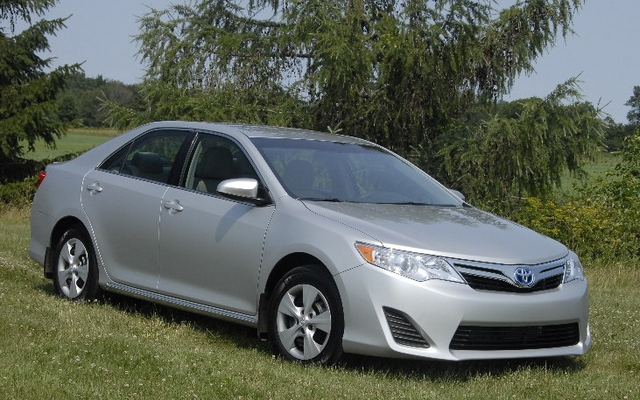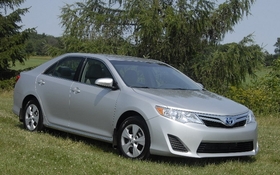2012 Toyota Camry: Improved, but still conservative

| Strong points |
|
|---|---|
| Weak points |
|
We would have liked to introduce you to the new 2012 Camry earlier, but we were under a strict embargo until August 23. In theory, this embargo applied for all of North America, and since our policy at The Car Guide is to respect the publication dates demanded by the manufacturers, we ignored the 2012 model in this year’s edition of Le Guide de l’auto. But the fateful date has now come and gone and we are finally able to talk to you about this newcomer.
Differing opinions
If you trust what the powers that be at Toyota are saying in their press releases, this Camry is a car with an extraordinary look and powered by very hi-tech engines. Its passenger compartment is roomy, comfortable and the most respected interior designs in the category pale in comparison to that of the Camry. And of course, with ten air bags in the passenger compartment, safety is unparalleled! And don’t forget Toyota’s ever-present legendary quality.
Naturally, these people have to give a very enthusiastic description of this vehicle, since it’s their job to sing the praises of their new sedan. I’m writing any way to present my own assessment of the car, as I am paid to give my opinion.
New silhouette? Sort of...
Some journalists have said that the previous version of the Camry was about as glamorous as a dishwasher. However, it must be said that this shape made it look like a luxury car. A black Camry with tinted windows is impressive and looks a lot more expensive than it actually is. And although it wasn’t a particularly original car, it did have a certain quality. However, the same cannot really be said of the new generation. Toyota thinks that the front end gives the car a sporty look. I disagree, and I think it’s rather drab. The same goes for the tail end, which is extremely plain. In fact, the only person that this part of the car will get a rise out of us the designer of the Subaru Legacy’s taillights, who will undoubtedly recognize his or her work in this Toyota.
An exciting newcomer? I don’t think so. It’s rather plain, balanced and probably reflects the tastes of this car’s traditional buyers. In an attempt to impress us more, the folks at Toyota talked about small deflectors located on the exterior rearview mirror and along the side wall of the taillight. This little outgrowth is supposed to create a vortex along the body in order to reduce air resistance. If they are to be believed, this revolutionary technology is derived from Toyota’s Formula 1 cars. Now I understand why this manufacturer pulled out of this championship...
On the other hand, it’s a lot nicer inside. Overall it remains a tad disparate and you get the impression that the central part of the dashboard, where the display screen is found, was designed by a different person than the one who did the indicator dials and the steering wheel. However, there’s no shortage of space and both the front and back seats are comfortable. The seatbacks have been sculpted so as to provide more legroom for those in the backseats. As you’d expect on one of this brand’s cars, the quality of the finish and materials is impeccable. Nevertheless, the dashboard is decidedly dispassionate. One need only compare it to that of the recent Hyundai Sonata and Kia Optima to deduce that the boldest stylists are now in Korea.
Known mechanics
Toyota built its reputation and its sales on the reliability of their mechanical components, so clearly it was in their best interests to use known components that have proven their value over the years. After the sticking accelerators fiasco and other technical problems that led to multiple recalls worldwide, they dared not mess with the drivetrains. Instead, they settled for refining and improving a few features here and there.
The models with traditional engines still come with the 2.5-litre four-cylinder that now produces 179 horses and 171 lbs-ft of torque, in addition to a combined city/highway fuel consumption of 7.7 litres/100 km. If you like the smoothness of V6 engines, you’re in luck. The 3.5-litre V6 with an aluminum alloy engine bloc is back, and it produces a maximum power of 268 horses and 248 lbs-ft of torque. Toyota is announcing a combined city/highway fuel consumption of 8.9 L/100 km. Both of these engines benefit from the double variable valve timing with intelligence (double VVT-i), sequential multi-point fuel injection, Toyota’s electronic throttle control system with intelligence (ETCS-i), acoustic control induction system (ACIS) and a lot more. Both models featuring conventional engines are paired with a six-speed automatic transmission.
The brand new Camry hybrid has a highly modified version of the brand’s Hybrid Synergy Drive, particularly with a new four-cylinder 2.5-litre engine.
Thanks to its single transaxle, Hybrid Synergy Drive combines the power of the four-cylinder gas engine with that of a small electric motor with higher torque. Overall, it produces a combined power of 200 horses and can vary the power of the gas engine and the electric motor, or combine both if necessary. This new 2.5-litre engine uses the Atkinson cycle for maximum efficiency. The intake camshaft’s variable valve timing with intelligence (VVT-i) improves the torque, which is better than that of the previous engine. New on the 2012 Camry hybrid is the possibility of driving the car with only the electric motor over a distance of up to 2.5 kilometres at low speed (less than about 40 km/hr). The EV indicator lights up when the vehicle is powered only its electric motor. According to Toyota Canada, the new Camry Hybrid offers greatly reduced fuel consumption compared to the previous version.
Sporty? Not this car...
It’s true that the new Camry has been modified from all angles and that the passenger compartment – particularly the dashboard – is much more modern than before, but there’s a big difference between that and a fun, sporty ride. In a Toyota video broadcast in the United States, the host is wearing a shirt bearing the Toyota Sport logo when he’s introducing new Camry. I think that’s a sham. It’s more impressive when he’s talking about the airbags and dashboard in the video than the car’s dynamic qualities.
The Camry isn’t a bad car, quite the contrary. But it’s targeting a category of buyers that want a quiet ride, passenger compartment soundproofing and material and mechanical durability above all. These people want guaranteed value and a comfortable and very spacious family car. Passive safety is also a priority for these people. All of these features have been improved on the new Camry.
Our presentation of this new model was relatively cursory and fast. Our road experience was limited to a few laps at the circuit in Saint-Eustache. Nevertheless, we were able to confirm that the car handles better, is better soundproofed and that the power-steering gives acceptable feedback from the road for this type of mechanics. The rest isn’t exactly thrilling. The Camry is still a peaceful car, quiet as a mouse, a vehicle that will please those who like to ride in a silent, comfortable environment.
We’ll have the chance, in the weeks and months to come, to get behind the wheel and do more exhaustive testing. But for now, I’m of the opinion that Toyota settled for refining the features that made the car successful. The manufacturer can’t be criticized for this decision. However, neither the silhouette nor the driveability seems to have been targeted by those responsible for this car’s makeover.
But considering the very significant number of buyers looking for silence, safety and satisfaction, I’m already will to bet that this newcomer will be very successful. Nevertheless, people won’t be able to resist comparing it to the Kia Optima or Hyundai Sonata, and I’m not sure that the Japanese will win that contest. And don’t forget that Mazda is promising something spectacular with its new Mazda6 that should be unveiled in the spring of 2012...And how about the new VW Passat ?











